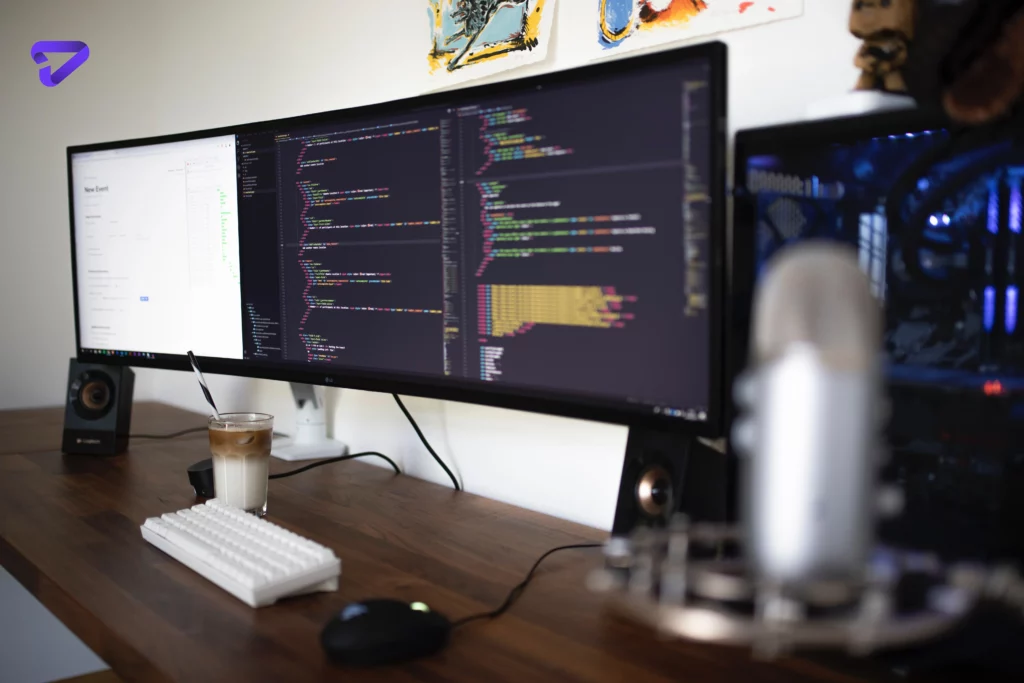
Does web design require coding?
Have you ever wondered – does web design require coding? Or is it possible to create websites without writing a single line of code? You may find this question confusing if you’re new to web design.
The short answer is: it depends. Read on to understand the nuanced relationship between web design and coding.
Web Design vs. Web Development
Before diving in, understanding the difference between web design and web development is essential.
Webdesign focuses on the aesthetics and visual layout of a website. Web designers utilize tools like Photoshop, Illustrator, and InDesign to create the look and feel of a site.
On the other hand, web development deals with a website’s technical backend. This includes coding languages like HTML, CSS, JavaScript, and PHP to build the underlying structure and add functionality.
Webdesign and web development work hand-in-hand. A beautifully designed site will only function with the correct code behind it.
Does UI/UX Require Coding?
So, does ui ux require coding? User interface (UI) and user experience (UX) design also play a crucial and significant role in webdesigner.
UI refers to all the visual elements that allow users to interact with a product easily. This includes buttons, menus, and how information is structured on the screen.
UX deals with a website or app’s overall feel and ease of use. UX designers focus on intuitive navigation, simplifying complex tasks, and creating an enjoyable experience.
UI designers often utilize design software like Sketch, Figma, or Adobe XD to lay out interfaces. These tools use a drag-and-drop approach – no coding is needed.
However, many UI designers have working knowledge of HTML and CSS. This allows them to implement their designs and work closely with developers. An understanding of JavaScript is also helpful in adding interactivity.
UX design doesn’t always require coding skills. But as a UX designer, conversing in HTML and CSS helps bring your visions to life. Familiarity with web development concepts is also beneficial.
Does Web Design Involve Coding?
Now we get to the heart – does web design involve coding?
The short answer is yes. While visual design tools are critical parts of a web designer’s toolkit, coding forms the core foundation of web design.
Here’s a quick overview of the vital coding languages:
- HTML: The skeleton of every website. HTML provides structure and creates the blueprint.
- CSS: Adds styling like colors, fonts, and layouts to make sites visually appealing.
- JavaScript: Powers interactivity and dynamism through click events, animations, and more.
- PHP, Python, Ruby: Server-side languages to build complex web apps and connect to databases.
You don’t need to be an expert coder to design websites. But having a working knowledge of HTML and CSS is absolutely vital. Many web designers also pick up JavaScript to enhance user experiences.
Coding allows web designers to bring their visual designs to life on the web. Understanding web languages is indispensable even if you don’t write all the code yourself.
Is Web Design Coding Hard to Learn?
Wondering is web design coding hard? As a creative, learning to code can seem daunting at first. But here are a few reasons why web design coding isn’t as hard as you might think:
- Beginner-friendly resources: From interactive courses on FreeCodeCamp to tutorials on YouTube, there are plenty of free, engaging resources to learn web languages.
- Visual nature: Web languages utilize a visual canvas, unlike purely text-based coding. Seeing your code take shape on screen helps accelerate learning.
- Instant gratification: Coding for web design often provides instant feedback. Tweak some CSS and immediately see colors or fonts change on your site. This sense of achievement helps boost motivation.
- Logical and learnable: HTML and CSS have logical, predictable syntax compared to hardcore coding languages. Their Lego-block-like nature makes web languages learnable for visually-oriented people.
- Designer-friendly: Web design coding prioritizes appearance, layout, and styling – areas designers already have sensibilities for. This makes picking up HTML and CSS intuitive.
Bonus Tips to Consider On Web Design and Coding
- Coding is an invaluable skill, even if you work with developers. Knowing HTML and CSS allows you to better communicate and collaborate with engineering teams. You’ll provide cleaner design specs and understand technical constraints.
- JavaScript is also becoming more important for web designers to learn. With the rise of interactivity and web animations, JS powers many of these experiences. Understanding basics like DOM manipulation, events, and jQuery will make you a well-rounded designer.
- While you don’t need to become a full-stack developer, learning backend languages like PHP or Python allows you to build functional prototypes and test ideas quickly. This enables faster iteration and testing of UX concepts.
- Frameworks and libraries like Bootstrap, React, and Vue.js are also useful tools for web designers to gain familiarity with. They provide pre-built components to build and style sites rapidly. Many companies now build sites using these technologies.
- Understanding web design principles like responsiveness, accessibility, and web performance optimization is also key. Coding skills allow you to implement these best practices when building sites and prototypes.
- With the rise of Web3, learning web languages provides opportunities in cutting-edge areas like blockchain, metaverse, and crypto projects. Many companies are looking for design talent with coding capabilities in this space.
- Even basic web coding skills open the door to more career options – front-end developer, UX engineer, web producer, and hybrid design/developer roles. Coding expands your possibilities beyond just visual design work.
-
Closing Thoughts
- So does web design require coding? In most cases, yes – at least a foundational understanding of HTML and CSS. While visual design software and drag-and-drop website builders are tempting shortcuts, hands-on coding skills remain invaluable. Hopefully, this piece helped demystify the relationship between web design and coding. Our team can provide diverse web design services tailored to your business requirements.To learn more about our Charlotte website design services, reach us from below.
For more information, please follow us on our Social Media. Instagram, Facebook












